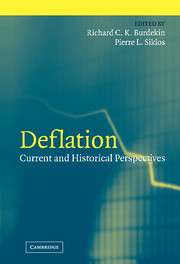Book contents
- Frontmatter
- Contents
- List of Tables and Figures
- List of Contributors
- Preface
- 1 Fears of Deflation and the Role of Monetary Policy: Some Lessons and an Overview
- PART ONE FEARS OF DEFLATION AND THE ROLE OF MONETARY POLICY
- PART TWO DEFLATION AND ASSET PRICES
- PART THREE INTERNATIONAL PERSPECTIVES ON DEFLATION
- PART FOUR STOCK MARKET ADJUSTMENTS TO DEFLATION
- 10 Deflation, the Financial Crises of the 1890s, and Stock Exchange Responses in London, New York, Paris, and Berlin
- 11 The Stock Market and the Business Cycle in Periods of Deflation, (Hyper-) Inflation, and Political Turmoil: Germany, 1913–1926
- 12 Deflationary Pressures and the Role of Gold Stocks: 1929, 1987, and Today
- References
- Index
- Titles in the series
11 - The Stock Market and the Business Cycle in Periods of Deflation, (Hyper-) Inflation, and Political Turmoil: Germany, 1913–1926
Published online by Cambridge University Press: 15 December 2009
- Frontmatter
- Contents
- List of Tables and Figures
- List of Contributors
- Preface
- 1 Fears of Deflation and the Role of Monetary Policy: Some Lessons and an Overview
- PART ONE FEARS OF DEFLATION AND THE ROLE OF MONETARY POLICY
- PART TWO DEFLATION AND ASSET PRICES
- PART THREE INTERNATIONAL PERSPECTIVES ON DEFLATION
- PART FOUR STOCK MARKET ADJUSTMENTS TO DEFLATION
- 10 Deflation, the Financial Crises of the 1890s, and Stock Exchange Responses in London, New York, Paris, and Berlin
- 11 The Stock Market and the Business Cycle in Periods of Deflation, (Hyper-) Inflation, and Political Turmoil: Germany, 1913–1926
- 12 Deflationary Pressures and the Role of Gold Stocks: 1929, 1987, and Today
- References
- Index
- Titles in the series
Summary
INTRODUCTION
With the onset of a deflation in stock prices beginning in early 2000, economists and policy makers have begun to worry that this development might eventually spill over into the goods market, possibly leading to a recession, if not outright depression, and that it is symptomatic of a “bad” deflation (see Bordo and Redish in this volume). The fact that political turmoil, and its attendant uncertainties, is also a feature of current events, stemming from the terrorist attacks of September 11, 2001, the subsequent wars in Afghanistan and Iraq, and a general economic malaise in Europe and the United States just to name a few events, only adds to the fears that deflation ought to be avoided at all costs. Implicit in such views is that financial markets in particular, and economies more generally, operate differently in a deflationary environment than in conditions of inflation. Although it is too early to tell how ongoing developments in asset prices will unfold, it may be useful to examine a period in economic history that has all of these elements to try and learn how widely accepted views about the determinants of asset prices, and their potential links to the real economy, fare under conditions of deflation, inflation, or even hyper-inflation.
More precisely, the aim of this chapter is to provide empirical evidence on the long run validity of the present value model of asset price determination and the characteristics of the short run dynamics away from the long run equilibrium. We also investigate the long run and short run behavior of the link between stock prices and the business cycle.
- Type
- Chapter
- Information
- DeflationCurrent and Historical Perspectives, pp. 298 - 317Publisher: Cambridge University PressPrint publication year: 2004
- 1
- Cited by



